In honor of the two-year anniversary of the James Webb Space Telescope (JWST) beginning to send images back to Earth, NASA has released another stunning image taken by the revolutionary space telescope.
The second anniversary JWST image shows two interacting galaxies that make up a single object, called Arp 142, which looks like a cosmic penguin with its cosmic egg. Fittingly, the celebration of two years of science achievements from the JWST, the new image is a two-for-two. The Penguin and Egg scene of Arp 142 features two interacting galaxies located about 326 million light-years from Earth in the constellation Hydra. It has been observed before, but never in as much detail as this view from the JWST has allowed.
Related: James Webb Space Telescope Sees Ancient Black Hole Dancing With Colliding Galaxies
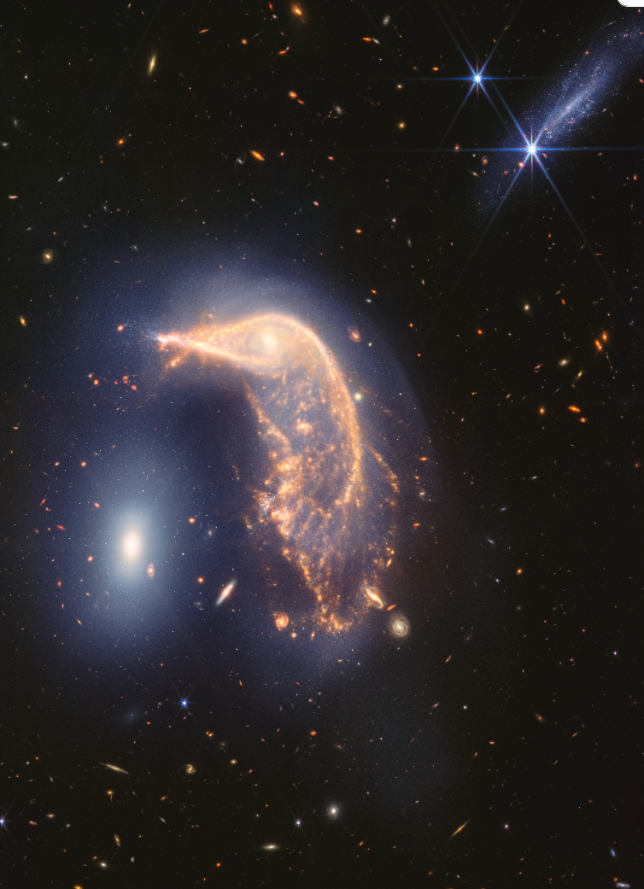
“In just two years, the JWST has transformed our view of the universe, enabling the kind of world-class science that drove NASA to make this mission a reality,” said Mark Clampin, director of the Astrophysics Division at NASA Headquarters in Washington, in a statement. “The JWST is providing insights into long-standing mysteries of the early universe and ushering in a new era of studying distant worlds, sending back images that inspire people around the world and raising exciting new questions to answer.”
“Never before has it been possible to explore every aspect of the universe.”
Galaxies throw a party for the JWST
In the new image, Arp 142 is seen in infrared light by the JWST’s Near-Infrared Camera (NIRCam) and Mid-Infrared Instrument (MIRI); the “penguin” is a misshapen spiral galaxy called NGC 2936, while its “egg” is the galaxy NGC 2937. The two galaxies are about 100,000 light-years apart, which is actually quite close in galactic terms. For example, the Milky Way and its nearest neighbor, Andromeda, are about 2.5 million light-years apart.
The interaction between Arp 142 began between 25 and 75 million years ago, when the two galaxies first passed each other, disrupting the spiral shape of NGC 2936. As the interaction continues, more golden threads will be pulled from this cosmic penguin until the galaxies eventually collide and merge.
Within the penguin portion of this duo, the galactic center of NGC 2936 shines like a bright shining eye in the cosmic waterbird’s head. The unwinding arms of gas, dust, and stars of NGC 2936 form the penguin’s beak, head, back, and fanned tail.
Like most spiral galaxies, NGC 2936 is rich in gas and dust, which is being pulled in by the egg half of the galaxy, NGC 2937. This creates regions of increased gas density in NGC 2936 that are causing bursts of star formation. These regions can be seen in the beak, feathers, and tail of the Penguin in the JWST image.
The new stars are surrounded by orange, smoky gas containing carbon-bearing molecules called polycyclic aromatic hydrocarbons (PAHs), which the JWST can now see clearly. While Penguin tells a story of disruption and upheaval, the galaxy its egg represents is relatively undisturbed. NGC 2937 is an elliptical galaxy packed with older stars than NGC 2936. It has less gas and dust than its companion, meaning the interaction doesn’t trigger the same periods of intense star formation.
The fact that the Penguin and its egg have roughly the same mass has prevented one galaxy from simply swallowing the other.
Birthday Party Tricks
Of course, NASA wouldn’t be able to throw a party for the JWST if only two galaxies arrived.
The galaxy PGC 1237172 is at the upper right of the Penguin and Egg image. The blue swoop is an edge-on view of this young galaxy, which is packed with blue baby stars and lies just 100 million light-years from Earth.
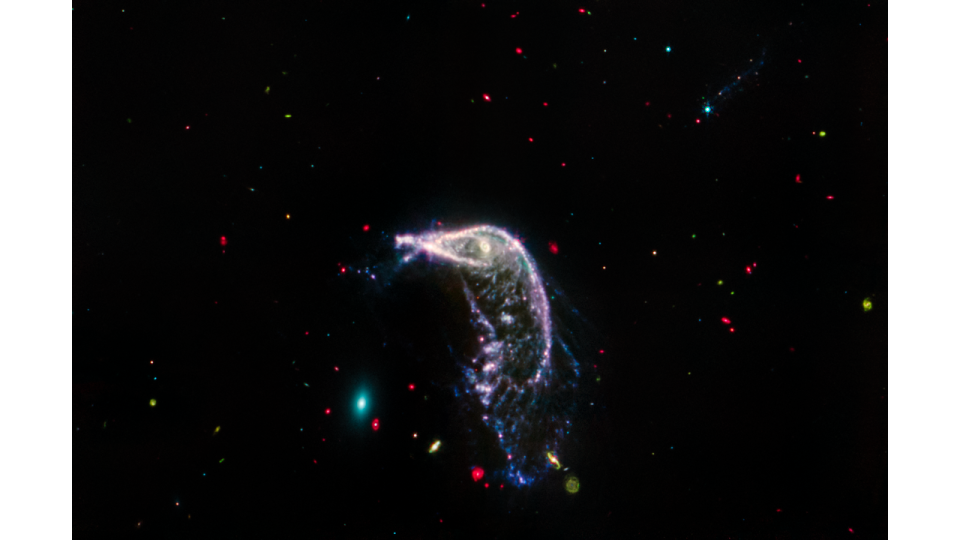

PGC 1237172 also pulls off quite a party trick for the JWST. The blue edge-on galaxy disappears when the same region is viewed in the mid-infrared by MIRI (above).
Sorry to spoil the illusion. This happens because MIRI is better at seeing mid-infrared light from older stars and dust, with the abundant young stars of this galaxy disappearing in those wavelengths of light.
The rest of the company is made up of a large number of other distant galaxies, some half-hidden in the tail feathers of NGC 2936, while others shine faintly in the background.
Two years of JWST
The JWST launched on Christmas Day 2021, but spent its first few months in space calibrating its instruments in preparation for observing the cosmos in infrared light. On July 11, 2022, President Biden and Vice President Harris unveiled the first image from the $10 billion telescope during a press conference from the White House.
This image shows the galaxy cluster SMACS 0723. This image is known as the first deep-field image from the JWST.
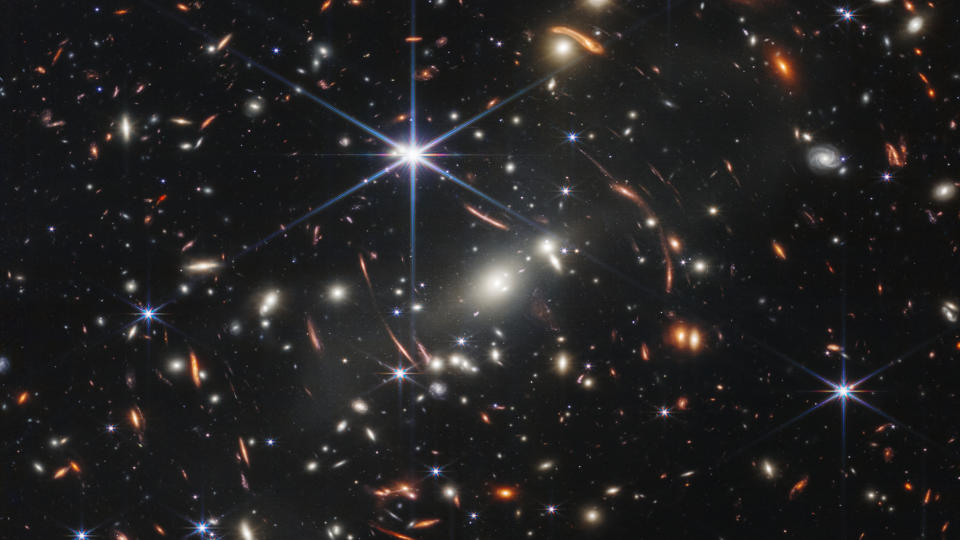

This revelation was followed a day later by a live broadcast from NASA, showing three more stunning images from the JWST. This event is marked by the release of these new images.
The imaged objects, unveiled to the public on July 12, 2022, included Stephan’s Quintet, the cosmic cliffs of the Carina Nebula, and some supernova debris left behind by a dying star. These images were accompanied by data collected by the JWST from the atmosphere of the hot gas giant exoplanet WASP-96 b.
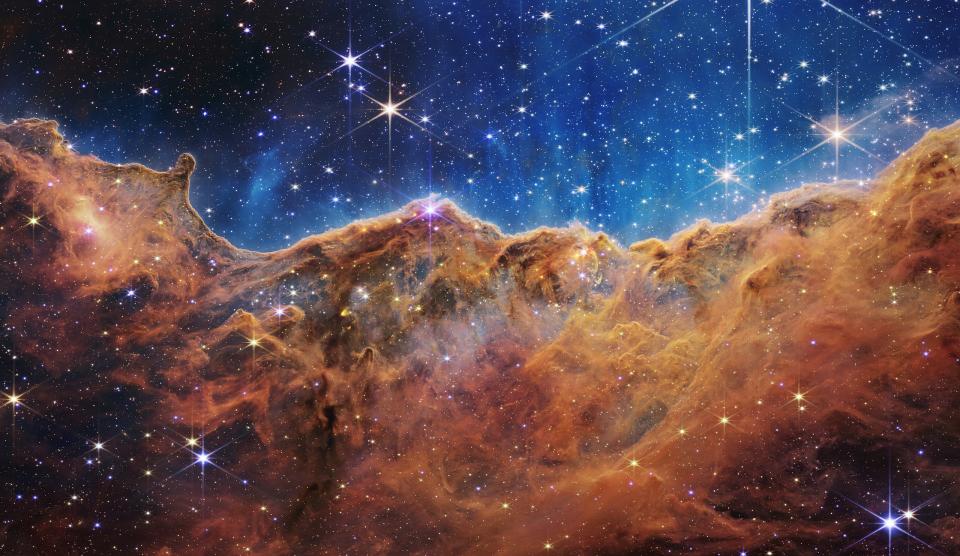

In the two years since then, the JWST has continued to deliver images of stunning beauty while providing scientists with data that has revolutionized our knowledge of the cosmos.
The JWST has seen the most distant galaxies ever seen by humanity, some of which are so distant that they existed when the 13.8 billion-year-old cosmos was only 300 million years old. The most powerful space telescope ever has also detected quasars powered by supermassive black holes that existed less than 1 billion years after the Big Bang. This has essentially posed a huge problem for cosmologists in explaining how these titans grew so enormous so quickly in the early universe.
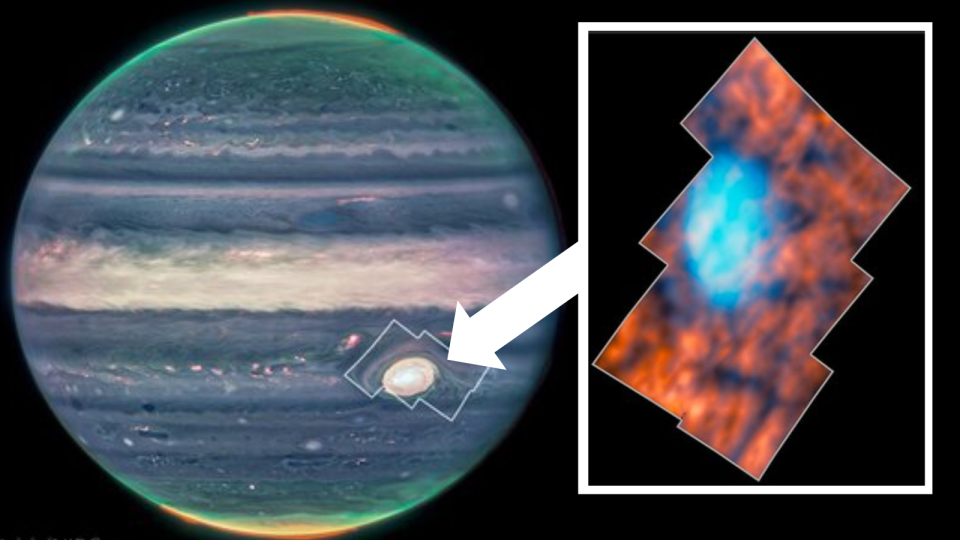

The JWST is adept at spotting light from galaxies whose wavelengths have been “stretched” by the expansion of the universe as the light has traveled through the cosmos for billions of years. That’s why the telescope is so good at seeing early galaxies and quasars.
But astronomers didn’t expect the space telescope to be so useful closer to home, specifically in our solar system. It was a pleasant surprise. Instead of being blinded by nearby objects, as astronomers feared, the powerful space telescope has been able to cast familiar bodies in the solar system, such as Jupiter (pictured above), in an incredible new light.
RELATED STORIES:
— Galaxy M87’s giant black hole shoots out jets at near the speed of light
— Brightest quasar ever observed is powered by a black hole eating a ‘sun a day’
— The first black hole ever captured by humans has warped magnetic fields and scientists are excited about it
“Since President Biden and Vice President Harris unveiled the first image from the James Webb Space Telescope two years ago, Webb has continued to unravel the mysteries of the universe,” NASA Administrator Bill Nelson said in the statement. “With remarkable images from corners of the cosmos dating back nearly to the beginning of time, the JWST’s capabilities are shedding new light on our celestial neighborhood and inspiring future generations of scientists, astronomers and explorers.”